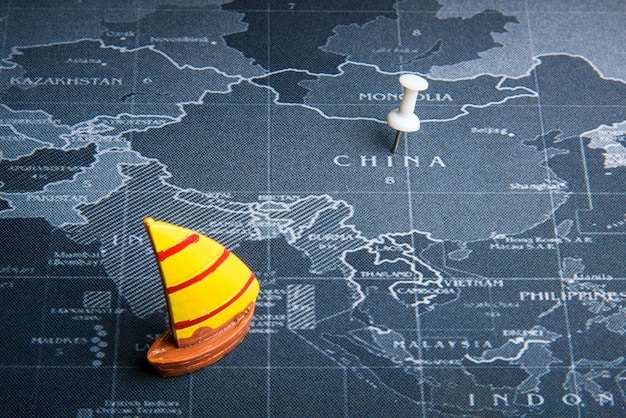US Military Strategy in the South China Sea: Countering China’s Expansion

The US Military’s Strategy for Countering China’s Military Expansion in the South China Sea involves a multifaceted approach, encompassing naval presence, alliances, and forward deployment of assets to maintain regional stability and deter further Chinese encroachment.
The South China Sea has become a focal point of geopolitical tension, with China’s assertive actions raising concerns among regional neighbors and the United States. Understanding the US Military’s Strategy for Countering China’s Military Expansion in the South China Sea is crucial for comprehending the dynamics of this critical waterway. This article delves into the key components of this strategy, examining its strengths, limitations, and implications for the future of the region.
Understanding the Geopolitical Landscape
The geopolitical landscape of the South China Sea is complex, characterized by overlapping territorial claims and competing strategic interests. China’s expansive claims, often referred to as the “nine-dash line,” encompass a vast area of the sea, leading to disputes with neighboring countries such as Vietnam, the Philippines, Malaysia, and Brunei. These disputes revolve around the sovereignty of islands, reefs, and resources within the South China Sea, including vital shipping lanes and potential oil and gas reserves.
China’s Military Buildup in the South China Sea
China has undertaken a significant military buildup in the South China Sea, including the construction of artificial islands on disputed reefs. These islands have been equipped with military facilities, such as airfields, radar installations, and missile batteries, enhancing China’s ability to project power and assert its claims in the region. This buildup poses a direct challenge to the principle of freedom of navigation and raises concerns about the militarization of the South China Sea.
- China’s island-building activities have significantly altered the strategic landscape of the South China Sea.
- The deployment of military assets on these islands enhances China’s surveillance and control capabilities.
- These actions have heightened tensions with neighboring countries and the United States.
The US views China’s actions as a violation of international law and a threat to regional stability. The US has consistently asserted its right to conduct freedom of navigation operations (FONOPs) in the South China Sea to challenge China’s excessive maritime claims and demonstrate its commitment to maintaining open access to the waterway. These operations involve US Navy warships and aircraft operating within the disputed areas, asserting the principle that all countries have the right to navigate and fly in international waters and airspace.
Key Elements of the US Military’s Strategy
The US Military’s Strategy for Countering China’s Military Expansion in the South China Sea is multifaceted, encompassing several key elements designed to deter Chinese aggression and maintain regional stability. These include maintaining a strong naval presence, strengthening alliances and partnerships, and enhancing military capabilities.
Maintaining a Strong Naval Presence
A cornerstone of the US strategy is the continuous presence of US Navy warships in the South China Sea. This presence serves as a visible demonstration of US commitment to the region and provides a deterrent against Chinese actions. US Navy ships conduct regular patrols, exercises, and freedom of navigation operations, signaling to China and other regional actors that the US is determined to uphold international law and protect its interests.

The US Navy also conducts joint exercises with regional allies, such as Japan, Australia, and the Philippines, enhancing interoperability and strengthening defense cooperation. These exercises demonstrate a unified front against potential aggression and reinforce the US commitment to collective security.
Strengthening Alliances and Partnerships
Recognizing the importance of collective action, the US actively seeks to strengthen its alliances and partnerships in the Indo-Pacific region. This includes deepening defense cooperation with key allies such as Japan, South Korea, Australia, and the Philippines, as well as building new partnerships with countries like India and Vietnam. These partnerships are crucial for sharing intelligence, coordinating military operations, and presenting a united front against Chinese expansionism.
Through diplomatic engagement and security assistance programs, the US encourages regional countries to invest in their own defense capabilities and enhance their maritime security. The US also supports regional institutions such as the Association of Southeast Asian Nations (ASEAN) in promoting a rules-based order in the South China Sea.
Taken together, these strategies are all vital parts of the US Military’s Strategy for Countering China’s Military Expansion in the South China Sea.
Forward Deployment and Enhanced Capabilities
In addition to maintaining a strong naval presence and strengthening alliances, the US is also focused on forward deployment of military assets and enhancing its capabilities to respond effectively to potential threats in the South China Sea. This includes deploying advanced weapons systems, improving intelligence gathering and surveillance capabilities, and developing new operational concepts.
- The US is investing in advanced technologies such as unmanned aerial vehicles (UAVs) and autonomous underwater vehicles (AUVs) to enhance its surveillance capabilities in the South China Sea.
- The deployment of long-range strike capabilities, such as the B-2 Spirit bomber and the Tomahawk cruise missile, provides the US with the ability to project power deep into the region.
- The US is also developing new operational concepts, such as distributed maritime operations (DMO), to enhance its ability to operate in a contested environment.
The continued enhancement of military assets is a crucial part of the US Military’s Strategy for Countering China’s Military Expansion in the South China Sea.
The US military is adapting its force posture in the Indo-Pacific region to be more resilient and distributed. This involves dispersing forces across a wider range of locations, reducing reliance on large, centralized bases, and enhancing the ability to operate from austere and contested environments.
Challenges and Limitations
While the US Military’s Strategy for Countering China’s Military Expansion in the South China Sea has enjoyed some success, it is not without its challenges and limitations. China’s growing military power, its economic influence in the region, and its willingness to assert its claims despite international criticism pose significant obstacles to the US strategy.
China’s Anti-Access/Area Denial (A2/AD) Capabilities
China has invested heavily in anti-access/area denial (A2/AD) capabilities, such as anti-ship ballistic missiles and advanced air defense systems, designed to deter US military forces from operating within the first island chain, which includes the South China Sea. These capabilities pose a significant challenge to US naval operations and complicate the task of maintaining a credible deterrent in the region.
Overcoming China’s A2/AD capabilities requires the US to develop new operational concepts and invest in advanced technologies, such as electronic warfare systems and stealth platforms, to mitigate the effectiveness of Chinese defenses.
Economic Considerations
China’s economic influence in the region also presents a challenge to the US strategy. Many countries in Southeast Asia are heavily reliant on trade and investment with China, making them hesitant to openly confront China’s actions in the South China Sea. The US needs to offer viable economic alternatives to these countries to reduce their dependence on China and encourage them to align with US interests.

Pursuing trade agreements and investment initiatives that promote economic growth and diversification in the region can help to counter China’s economic leverage and strengthen US influence.
The US Military has to balance a variety of competing factors when considering its US Military’s Strategy for Countering China’s Military Expansion in the South China Sea.
The Future of US Strategy in the South China Sea
The future of US strategy in the South China Sea will likely involve a continuation of current efforts, with an increased emphasis on innovation, adaptability, and multilateral cooperation. The US will need to continue to invest in advanced military capabilities, strengthen its alliances and partnerships, and work with regional institutions to promote a rules-based order in the South China Sea.
Embracing Innovation and Adaptability
To effectively counter China’s growing military power, the US military needs to embrace innovation and adaptability. This includes developing new operational concepts, investing in advanced technologies, and fostering a culture of experimentation and learning. The US military must be prepared to adapt its strategy as China’s capabilities evolve and new challenges emerge.
- The US military should continue to experiment with new technologies such as artificial intelligence, robotics, and directed energy weapons to enhance its capabilities in the South China Sea.
- The US military should also foster a culture of innovation and learning, encouraging its personnel to challenge conventional wisdom and develop new approaches to warfare.
- These ideas are essential to the evolving the US Military’s Strategy for Countering China’s Military Expansion in the South China Sea.
By embracing innovation and adaptability, the US military can maintain its competitive edge and deter Chinese aggression in the South China Sea.
Promoting Multilateral Cooperation
Addressing the challenges in the South China Sea requires a multilateral approach, involving cooperation among the US, its allies and partners, and regional institutions. The US should continue to work with these actors to promote a rules-based order, resolve disputes peacefully, and ensure freedom of navigation in the South China Sea.
Supporting regional initiatives such as the ASEAN Outlook on the Indo-Pacific can help to foster a common understanding of the challenges and opportunities in the region and promote cooperation on issues of mutual concern.
| Key Point | Brief Description |
|---|---|
| 🚢 Naval Presence | Continuous US Navy presence to deter Chinese actions and uphold international law. |
| 🤝 Alliances | Strengthening partnerships with regional allies for collective security. |
| 🚀 Forward Deployment | Forward deployment of military assets and enhanced capabilities for effective threat response, a key part of the US Military’s Strategy. |
| 🛡️ Innovation | Embracing new technologies and operational concepts to maintain a competitive edge. |
Frequently Asked Questions
The primary objective is to deter Chinese expansionism and maintain regional stability by ensuring freedom of navigation and upholding international law. The US seeks to balance China’s growing influence through a multifaceted approach.
The US Navy conducts regular patrols, exercises, and freedom of navigation operations (FONOPs) within the South China Sea. These actions assert the right of all countries to navigate international waters and airspace without restriction.
Alliances with countries like Japan, Australia, and the Philippines are crucial. These partnerships facilitate intelligence sharing, coordinated military operations, and a united front against potential threats, enhancing regional security.
China’s growing military power, its anti-access/area denial (A2/AD) capabilities, and its economic influence in the region pose significant challenges. Overcoming these requires innovation, adaptability, and multilateral cooperation.
The US is investing in advanced technologies, developing new operational concepts, and fostering a culture of innovation. This includes exploring artificial intelligence, robotics, and distributed maritime operations to maintain a competitive edge. The US Military’s Strategy for Countering China’s Military Expansion in the South China Sea will continue to evolve.
Conclusion
The US Military’s Strategy for Countering China’s Military Expansion in the South China Sea is a complex and evolving endeavor. By maintaining a strong presence, strengthening alliances, embracing innovation, and promoting multilateral cooperation, the US seeks to deter Chinese aggression and maintain a stable and rules-based order in this vital waterway. Continued vigilance and adaptability will be essential to address the challenges posed by China’s growing power and protect US interests in the region.





